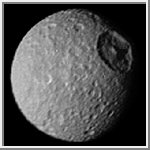
Saturn I
Mimas (pronounced MY muss or MEE muss, adjective Mimantean) is an inner moon of Saturn (the innermost of the major moons) and looks somewhat like a bull's eye if viewed from a certain angle. The feature that causes this is the huge 140-kilometer-wide (88-mile) Herschel Crater, which is one-third the diameter of Mimas. If the object striking Mimas had been larger or been moving faster, Mimas would probably have been "disrupted" into pieces that might have collapsed back into a new moon or might have scattered into another ring of Saturn. The walls of Herschel Crater are approximately 5 kilometers (3 miles) high, parts of the floor are approximately 10 kilometers (6 miles) deep, and the central peak towers are almost 6 kilometers (4 miles) above the floor of the crater. A comparable crater on Earth would be 4,000 kilometers (2,500 miles) in diameter.
Mimas averages 396 kilometers (246 miles) in diameter. Shock waves from the Herschel impact may have caused the fractures, also called chasmata, on the opposite side of Mimas. Mimas is not quite big enough to hold a round shape; the shape is somewhat ovoid with dimensions of 209 x 196 x 191 kilometers (130 x 122 x 119 miles, respectively). Mimas orbits at a range of 185,520 kilometers (115,280 miles) from Saturn in a time of 22 hours and 37 minutes. This orbit makes Mimas the closest major moon of Saturn. Mimas is tidally locked to Saturn with one side always facing in toward its parent. Mimas' close orbit means that Mimas probably receives several times the rate of collisions as the other moons of Saturn.
Mimas and another Saturn moon, Rhea, have been called "the most heavily cratered body in the Solar System." Mimas would probably have been more heavily cratered except, being closer to Saturn, Mimas was warmer (and consequently softer) for a longer time so early features have faded away. However, with so many impacts the youngest craters have tended to obliterate the older ones, and these moons are cratered about as much as they can get.
Most of the Mimas surface is saturated with impact craters ranging in size up to greater than 40 kilometers (25 miles) in diameter, although none are anywhere near the size of Herschel. However, the craters in the South Pole region of Mimas are generally 20 kilometers (12.4 miles) in diameter or less. This suggests that some melting or other resurfacing processes occurred there later than on the rest of the moon. (Interestingly, the South Pole area of Enceladus appears to be the source of that moon's geysers.)
Mimas' low density (1.17 times the density of liquid water) indicates that it is composed mostly of water ice with only a small amount of rock. It seems to be solidly frozen at a temperature of 209 degrees Celsius (-344 degrees Fahrenheit). This is puzzling because Mimas is closer to Saturn than Enceladus, and the Mimantean orbit is much more eccentric (out of round) than the Enceladean orbit. Thus, Mimas should have much more tidal heating than Enceladus. Yet, Enceladus has geysers of water, while Mimas has one of the most heavily cratered surfaces in the Solar System. This suggests a frozen Mimas surface that has persisted for a very long time. This paradox has led astronomers to use the "Mimas test" by which a theory to explain the partially thawed water of Enceladus must also explain the entirely frozen water of Mimas.
Mimas apparently cleared enough material to create the 4,800-kilometer (2,980-mile) wide gap (called the Cassini Division) between Saturn's two widest rings, the A and B rings. Observations from Cassini revealed that there is still some ring material in the Cassini Division, although it is sparse enough that the area appears dark from a distance.
Mimas is in resonance with two nearby moons, Dione and Enceladus. That is, these moons speed up slightly as they approach each other and slow down as they draw away, causing their orbits to vary slightly in a long series of complex changes, which help keep them locked in their positions.
Mimas strongly perturbs the tiny 3-kilometer (2-mile) diameter moon Methone, the 4-kilometer (3-mile) diameter moon Pallene, and the 2-kilometer (1-mile) diameter moon Anthe, all of which orbit between Mimas and the next major moon going out from Saturn, Enceladus. The vastly more massive Mimas causes the Methone orbit to vary by as much as 20 kilometers (12.4 miles). The perturbations are larger for tiny Anthe, and slightly smaller for Pallene.
Discovery
Ground-based astronomers could only see Mimas as little more than a dot until Voyagers I and II imaged it in 1980. The Cassini spacecraft has made several close approaches and provided detailed images of Mimas since Cassini achieved orbit around Saturn in 2004.
William [Friederick Wilhelm] Herschel discovered Mimas in 1789. His son, John Herschel suggested that the moons of Saturn be associated with Greek mythical brothers and sisters of Kronus, known to the Romans as Saturn.
The name Mimas comes from the god (or Titan) Mimas in Greek mythology who was slain by one of the gods of Olympus in the war between the Olympians and the titans. Different accounts have Mimas dispatched by Hercules, by Ares (the god of war), or by Zeus himself using a thunderbolt. Legend has it that the island of Prochyte near Sicily rests on his body.
Astronomers also refer to Mimas as Saturn I based on its distance being the closest to Saturn. The International Astronomical Union now controls the official naming of astronomical bodies.
| Mimas Statistics | |
|---|---|
| Discovered by | William Herschel |
| Date of discovery | 1789 |
| Mass (kg) | 3.80e+19 |
| Mass (Earth = 1) | 6.3588e-06 |
| Equatorial radius (km) | 196 |
| Equatorial radius (Earth = 1) | 3.0731e-02 |
| Mean density (gm/cm^3) | 1.17 |
| Mean distance from Saturn (km) | 185,520 |
| Rotational period (days) | 0.942422 |
| Orbital period (days) | 0.942422 |
| Mean orbital velocity (km/sec) | 14.32 |
| Orbital eccentricity | 0.0202 |
| Orbital inclination (degrees) | 1.53 |
| Escape velocity (km/sec) | 0.161 |
| Visual geometric albedo | 0.5 |
| Magnitude (Vo) | 12.9 |
| Mean surface temperature | -200°C |
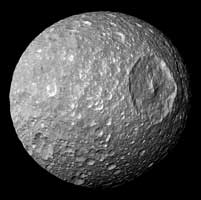 Flying by the "Death Star" Moon
Flying by the "Death Star" Moon
In this view captured by NASA's Cassini spacecraft on its closest-ever flyby of Saturn's moon Mimas, large Herschel Crater dominates Mimas, making the moon look like the Death Star in the movie "Star Wars."
Herschel Crater is 130 kilometers, or 80 miles, wide and covers most of the right of this image.
Cassini came within about 9,500 kilometers (5,900 miles) of Mimas on Feb. 13, 2010.This mosaic was created from six images taken that day in visible light with Cassini's narrow-angle camera on Feb. 13, 2010. The images were re-projected into an orthographic map projection. This view looks toward the area between the region that leads on Mimas' orbit around Saturn and the region of the moon facing away from Saturn. Mimas is 396 kilometers (246 miles) across. This view is centered on terrain at 11 degrees south latitude, 158 degrees west longitude. North is up. This view was obtained at a distance of approximately 50,000 kilometers (31,000 miles) from Mimas and at a sun-Mimas-spacecraft, or phase, angle of 17 degrees. Image scale is 240 meters (790 feet) per pixel.
(Courtesy NASA/JPL/Space Science Institute)
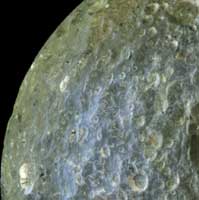 Streaked Craters in False-Color
Streaked Craters in False-Color
This false-color view of Saturn's moon Mimas from NASA's Cassini spacecraft accentuates terrain-dependent color differences and shows dark streaks running down the sides of some of the craters on the region of the moon that leads in its orbit around Saturn. The image was taken during Cassini's closest-ever flyby of the moon.
The false-color image shows how colors vary across the moon's surface, particularly the contrast between the bluish terrain on the right side of this view near Herschel Crater and greenish terrain elsewhere. The origin of the color differences (exaggerated by computer enhancement) is not yet understood, but may be caused by subtle differences in the surface composition between the two terrains.
This image also shows dark streaks trailing down the sides of some craters (marked red in the annotated version), often originating from pockets of dark contaminants embedded just below the rim of the crater wall. The pockets likely represent small, pre-existing, dark-floored craters that were buried by the blanket of material thrown out from the newer impact that created the crater rim. The material from a newly exposed dark layer eventually moves downslope and forms a streak. Streaks sometimes are seen originating from the floors of smaller dark-floored craters perched along rims of larger craters.
The craters seen in this mosaic also show relatively dark markings along the lower portion of their crater walls (marked in green in the annotated version of the image). Cassini scientists interpret this darkening as evidence for the gradual concentration of impurities from evaporating icy materials in areas where the dark impurities slide slowly down the crater wall and the bright ice is baked away by the sun and the vacuum of space.
To create this false-color view, ultraviolet, green and infrared images were combined into a single picture that exaggerates the color differences of terrain on the moon. These data were combined with a high-resolution image taken in visible light to provide the high-resolution information from the clear filter image and the color information from the ultraviolet, green, and infrared filter images. The natural color of Mimas visible to the human eye may be a uniform gray or yellow color.
This view looks toward the area between the region that leads in Mimas' orbit around Saturn and the region of Mimas that faces away from Saturn. Mimas is 396 kilometers (246 miles) across. This view is centered on terrain at 11 degrees north latitude, 156 degrees west longitude. This mosaic combines images taken with the Cassini spacecraft narrow-angle camera on Feb. 13, 2010. The view was acquired at a distance of approximately 34,000 kilometers (21,000 miles) from Mimas. Image scale is 180 meters (590 feet) per pixel.
(Courtesy NASA/JPL/Space Science Institute)
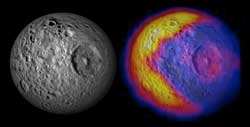 Bizarre Temperatures on Mimas
Bizarre Temperatures on Mimas
The image shows NASA's Cassini spacecraft imaging science subsystem visible-light mosaic of Mimas from previous flybys on the left. The right-hand image shows the new CIRS temperature data mapped on top of the visible-light image.
The annotated version illustrates the unexpected and bizarre pattern of daytime temperatures found on Saturn's small inner moon Mimas (396 kilometers, or 246 miles, in diameter). The data were obtained by the composite infrared spectrometer (CIRS) on the Cassini spacecraft during the spacecraft's closest-ever look at Mimas on Feb. 13, 2010.
In the annotated version, the upper left image shows the expected distribution of temperatures. The white sun symbol shows the point where the sun is directly overhead, which is at midday close to the equator. Just as on Earth, the highest temperatures (shown in yellow) were expected to occur after midday, in the early afternoon.
The upper right image in the annotated version shows the completely different pattern that Cassini actually saw. Instead of the expected smoothly varying temperatures, this side of Mimas is divided into a warm part (on the left) and a cold part (on the right) with a sharp, v-shaped boundary between them. The warm part has typical temperatures near 92 Kelvin (minus 294 Fahrenheit), while typical temperatures on the cold part are about 77 Kelvin (minus 320 Fahrenheit). The cold part is probably colder because surface materials there have a greater thermal conductivity, so the sun's energy soaks into the subsurface instead of warming the surface itself. But why conductivity should vary so dramatically across the surface of Mimas is a mystery.
The lower two panels in the annotated version compare the temperature map to Mimas' appearance in ordinary visible light at the time of the observations. The map used to create this image is a mosaic of images taken by Cassini's imaging science subsystem cameras on previous flybys of Mimas. The cold side includes the giant Herschel Crater, which is a few degrees warmer than its surroundings. It's not yet known whether Herschel is responsible in some way for the larger region of cold temperatures that surrounds it.
The green grid shows latitudes and longitudes on Mimas at 30-degree intervals.
Cassini took 85 minutes to make the temperature map, as the spacecraft receded from Mimas. During that time, the distance to Mimas increased from 38,000 to 67,000 kilometers (24,000 to 42,000 miles) and the longitude of the center of Mimas' disk increased from 128 degrees west to 161 degrees west, due to the moon's rotation.
Because of this changing geometry, the alignment of the temperatures relative to specific features or coordinates on Mimas is shown only approximately. The temperatures were calculated from the brightness of the moon's infrared heat radiation, measured by CIRS at a wavelength of 12 to 16 microns, and are color coded according to the scale in the lower right of the annotated figure.
(Courtesy NASA/JPL/GSFC/SWRI/SSI)
 Color Near Herschel Crater
Color Near Herschel Crater
Subtle color differences on Saturn's moon Mimas are apparent in this false-color view of Herschel Crater captured by NASA's Cassini spacecraft during its closest-ever flyby of that moon.
The image shows terrain-dependent color variations, particularly the contrast between the bluish materials in and around Herschel Crater (130 kilometers, or 80 miles, wide) and the greenish cast on older, more heavily cratered terrain elsewhere. The origin of the color differences is not yet understood, but may be caused by subtle differences in the surface composition between the two terrains. False color images from Cassini's previous closest encounter, in 2005, also showed such variations.
Herschel Crater covers most of the bottom of this image. To create this false-color view, ultraviolet, green and infrared images were combined into a single picture that exaggerates the color differences of terrain on the moon. These data were combined with a high-resolution image taken in visible light to provide the high-resolution information from the clear-filter image and the color information from the ultraviolet, green and infrared filter images.
The natural color of Mimas visible to the human eye may be a uniform gray or yellow color, but this mosaic has been contrast-enhanced and shows differences at other wavelengths of light.
During its closest-ever flyby on Feb. 13, 2010, Cassini came within about 9,500 kilometers (5,900 miles) of Mimas. This view looks toward the northern part of the hemisphere of Mimas that leads in the moon's orbit around Saturn. Mimas is 396 kilometers (246 miles) across. North on Mimas is up and rotated 12 degrees to the left.
The images were obtained with Cassini's narrow-angle camera on that day at a distance of approximately 16,000 kilometers (10,000 miles) from Mimas. The images were re-projected into an orthographic map projection. A black and white image, taken in visible light with the wide-angle camera, is used to fill in parts of the mosaic. Image scale is 90 meters (195 feet) per pixel.
(Courtesy NASA/JPL/Space Science Institute)
 Mimas Showing False Colors
Mimas Showing False Colors
False color images of Saturn's moon, Mimas, reveal variation in either the composition or texture across its surface.
During its approach to Mimas on Aug. 2, 2005, the Cassini spacecraft narrow-angle camera obtained multi-spectral views of the moon from a range of 228,000 kilometers (142,500 miles).
The image at the left is a narrow angle clear-filter image, which was separately processed to enhance the contrast in brightness and sharpness of visible features. The image at the right is a color composite of narrow-angle ultraviolet, green, infrared and clear filter images, which have been specially processed to accentuate subtle changes in the spectral properties of Mimas' surface materials. To create this view, three color images (ultraviolet, green and infrared) were combined into a single black and white picture that isolates and maps regional color differences. This "color map" was then superimposed over the clear-filter image at the left.
The combination of color map and brightness image shows how the color differences across the Mimas surface materials are tied to geological features. Shades of blue and violet in the image at the right are used to identify surface materials that are bluer in color and have a weaker infrared brightness than average Mimas materials, which are represented by green.
Herschel crater, a 140-kilometer-wide (88-mile) impact feature with a prominent central peak, is visible in the upper right of each image. The unusual bluer materials are seen to broadly surround Herschel crater. However, the bluer material is not uniformly distributed in and around the crater. Instead, it appears to be concentrated on the outside of the crater and more to the west than to the north or south. The origin of the color differences is not yet understood. It may represent ejecta material that was excavated from inside Mimas when the Herschel impact occurred. The bluer color of these materials may be caused by subtle differences in the surface composition or the sizes of grains making up the icy soil.
(Courtesy NASA/JPL/Space Science Institute)
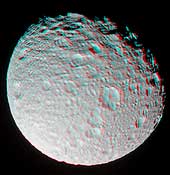 Mimas in 3D
Mimas in 3D
This 3D picture of Saturn's moon Mimas, shows it to be one of the most
heavily cratered Saturnian moons, with little if any evidence for
internal activity. Mimas has been so heavily cratered that new
impacts can only overprint or even completely obliterate other older
craters. Mimas is 397 kilometers or (247 miles) across.
The moon displays an unexpected array of crater shapes. The highest crater walls tower 6 kilometers (4 miles) above the floors and show signs of material sliding down slope. Indeed, many of the large craters -- more than 15 kilometers (10 miles) in diameter -- appear to be filled in with rough-surfaced material, likely the result of landslides triggered by subsequent impacts elsewhere on Mimas' surface. Some of these deposits have craters superimposed on them, demonstrating that the landslides themselves may be quite old.
Grooves, some of which are over a kilometer deep, cut across the surface for
more than 100 kilometers (63 miles). These are some of the only indications
that there might have once been internal activity under this ancient, battered surface.
(Copyright Calvin J. Hamilton)
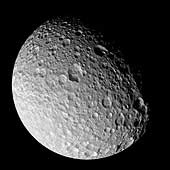 A World of Hurt
A World of Hurt
The most detailed images ever taken of Saturn's moon Mimas show it to be one of the most heavily cratered Saturnian moons, with little if any evidence for internal activity. Mimas has been so heavily cratered that new impacts can only overprint or even completely obliterate other older craters. Mimas is 397 kilometers or (247 miles) across.
The moon displays an unexpected array of crater shapes. The highest crater walls tower 6 kilometers (4 miles) above the floors and show signs of material sliding down slope. Indeed, many of the large craters -- more than 15 kilometers (10 miles) in diameter -- appear to be filled in with rough-surfaced material, likely the result of landslides triggered by subsequent impacts elsewhere on Mimas' surface. Some of these deposits have craters superimposed on them, demonstrating that the landslides themselves may be quite old.
Grooves, some of which are over a kilometer deep, cut across the surface for more than 100 kilometers (63 miles). These are some of the only indications that there might have once been internal activity under this ancient, battered surface.
(Courtesy NASA/JPL/Space Science Institute)
 Mimas & Herschel Crater
Mimas & Herschel Crater
This image of Mimas was acquired by the Voyager 1 spacecraft on
November 11, 1980 from a range of 425,000 kilometers (264,000 miles).
The large crater on the right limb is named Herschel. It
is 130 kilometers (80 miles) wide and one-third the
diameter of Mimas. Herschel is 10 kilometers (6 miles) deep,
with a central mountain almost as high as Mount Everest on Earth.
This impact probably came close to disintegrating the moon.
(Copyright Calvin J. Hamilton)
 Amazing Icy Moons
Amazing Icy Moons
A scene straight out of science fiction, this fantastic view shows, from
left to right, Saturn's moon's Mimas, Dione and Rhea, on the far side of
Saturn's nearly edge-on rings.
The trailing hemispheres of all three moons are sunlit here, and wispy
markings can be seen on the limbs of both Dione and Rhea. The diameter of
Mimas is 397 kilometers (247 miles), Dione is 1,118 kilometers (695 miles)
and Rhea is 1,528 kilometers (949 miles).
(Courtesy NASA/JPL/Space Science Institute)
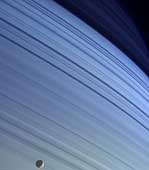 Mimas Blues
Mimas Blues
Mimas drifts along in its orbit against the azure backdrop of Saturn's
northern latitudes in this true color view. The long, dark lines on the
atmosphere are shadows cast by the planet's rings.
Saturn's northern hemisphere is presently relatively cloud-free, and rays of sunlight take a long path through the atmosphere. This results in sunlight being scattered at shorter (bluer) wavelengths, thus giving the northernmost latitudes their bluish appearance at visible wavelengths.
At the bottom, craters on icy Mimas (398 kilometers, or 247 miles across) give the moon a dimpled appearance.
Images taken using infrared (930 nanometers), green (568 nanometers) and ultraviolet (338 nanometers) spectral filters were combined. The colors have been adjusted to match closely what the scene would look like in natural color. See PIA06142 for a similar view in natural color.
The images were obtained using the Cassini spacecraft narrow angle camera
on Jan. 18, 2005, at a distance of approximately 1.4 million kilometers
(870,000 miles) from Saturn. Resolution in the image is 8.5 kilometers
(5.3 miles) per pixel on Saturn and 7.5 kilometers (4.7 miles) per pixel
on Mimas. The image has been contrast-enhanced to aid visibility.
(Courtesy NASA/JPL/Space Science Institute)
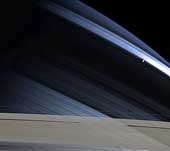 Nature's Canvas
Nature's Canvas
In a splendid portrait created by light and gravity, Saturn's lonely moon
Mimas is seen against the cool, blue-streaked backdrop of Saturn's
northern hemisphere. Delicate shadows cast by the rings arc gracefully
across the planet, fading into darkness on Saturn's night side.
The part of the atmosphere seen here appears darker and more bluish than the warm brown and gold hues seen in Cassini images of the southern hemisphere, due to preferential scattering of blue wavelengths by the cloud-free upper atmosphere.
The bright blue swath near Mimas (398 kilometers, or 247 miles across) is
created by sunlight passing through the Cassini division (4,800
kilometers, or 2,980 miles wide). The rightmost part of this distinctive
feature is slightly overexposed and therefore bright white in this image.
Shadows of several thin ringlets within the division can be seen here as
well. The dark band that stretches across the center of the image is the
shadow of Saturn's B ring, the densest of the main rings. Part of the
actual Cassini division appears at the bottom, along with the A ring and
the narrow, outer F ring. The A ring is transparent enough that, from
this viewing angle, the atmosphere and threadlike shadows cast by the
inner C ring are visible through it.
(Courtesy NASA/JPL/Space Science Institute)
 Mimas
Mimas
This is another image of Mimas acquired by the Voyager 1 spacecraft on
November 13, 1980. The surface is heavily cratered indicating an
ancient surface age.
(Copyright Calvin J. Hamilton)

 Saturn
Saturn Janus
Janus Enceladus
Enceladus